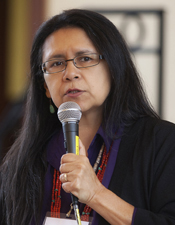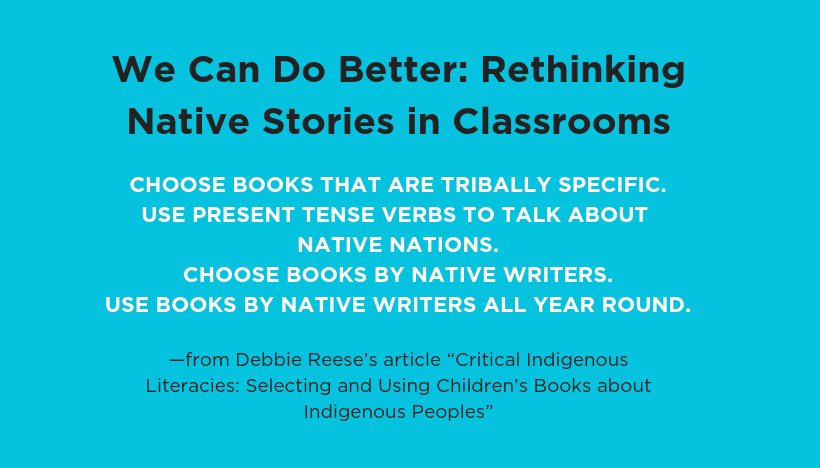This is an excerpt from Debbie Reese’s article “Critical Indigenous Literacies: Selecting and Using Children’s Books about Indigenous Peoples” in the July 2018 Language Arts. This article focuses on unlearning stereotypical representations of Indigenous peoples and replacing harmful narratives with accurate information and understandings. Teachers are critical in categorizing, selecting, and (re)presenting Indigenous communities through children’s literature.
Let’s turn, now, to Native American Heritage Month and its intersection with Thanksgiving.
Many teachers read aloud children’s books about the “First Thanksgiving.” Some classrooms take part in reenactments, with kids dressing up like Pilgrims and Indians or, perhaps, Wampanoags. Most of these books and activities default to stereotypes where Native people are shown in feathered headdresses and fringed clothing—items worn by Plains Indians rather than anything the Wampanoag people would have worn.
When teachers use Thanksgiving as the vehicle for their instruction about Native peoples, they are inadvertently locating Native lives in the past.
There are better ways to bring Native stories and books about Native peoples into classrooms. I focus on Cynthia Leitich Smith’s (2000) picture book Jingle Dancer to illustrate how classroom book collections depicting Native people could be improved.
The key ideas are to choose books that are tribally specific (that name a specific tribal nation and accurately present that nation), written by Native writers, set in the present day, and relevant all year round, keeping Native peoples visible throughout the school year.
Choose books that are tribally specific.
Select books about Native peoples who are/were residents of your specific state. I recommend using websites like the National Congress of American Indians and the Smithsonian’s National Museum of the American Indian for information on tribal nations. Smith’s picturebook is about Jenna, a little girl who is doing the jingle dance for the very first time at an upcoming powwow.
In the author’s note, Smith shares that Jenna is a citizen of the Muscogee Nation, pertinent to children in Georgia, where the Muscogee people originated, or in Oklahoma, where they are today. Therefore, focusing on the local context empowers tribal nationhood within the states of origin rather than focusing on politically constructed holidays like Thanksgiving.
Use present tense verbs to talk about Native Nations.
A teacher in Georgia might say, “Today, the Muscogee Creek Nation is in Oklahoma. Before Europeans arrived on what became known as the North American continent, the Muscogee Creeks were in Georgia.”
To go even further, use the provocative but accurate word “invaded” instead of “arrived.” While reading Jingle Dancer, which is set in the present day, show the Muscogee Nation website as a complementary source. Jenna’s house is in an everyday neighborhood and she is wearing clothes similar to kids in the classroom. She is a person of the present day.
Choose books by Native writers.
As noted earlier, Smith is Muscogee Creek. Introducing her as the author is another opportunity to use a present-tense verb. Because Smith and her character are Muscogee Creek, Jingle Dancer is an #OwnVoices story. As such, Smith is writing from her personal knowledge of Muscogee families and communities as they come together to help a child prepare and participate in a ceremonial dance for the first time. Jenna needs specific clothing, learns the steps and music, and understands the meaning of the dance from her tribal community.
At one point in the story, Jenna is feeling overwhelmed by all that she has to do. In a matter-of-fact way, Jenna’s great-aunt tells her about the story of Bat, which is a Creek creation story. As a result, we learn that Creek families share creation stories with each other to instill strength and as a way to carry on when feeling low or overwhelmed.
Use books by Native writers all year round.
Jingle Dancer can be used any time of the year. I’ve focused on it for most of this article, but it is only one of many books available. (A list of recommended books in a range of genres, all written by Native authors and tribally specific, follows the references.)
A middle grade teacher doing a unit on lyrics in pop music might consider using Eric Gansworth’s (2013) If I Ever Get Out of Here. It is tribally specific, set in the present day, and an #OwnVoices story. Every chapter title in the book is the name of a song by the Beatles or Paul McCartney. (If you’re a fan of either one, you’ll love the discography Gansworth has on his website!) Gansworth’s book is about the relationship that develops between Lewis, a Native boy living on the Tuscarora Reservation, and George, a White boy living on a nearby Air Force base.
Each year the market is flooded with problematic books that publishers market to classroom teachers, but there are also gems worth reading.
At my website, American Indians in Children’s Literature (https://americanindiansinchildrensliterature.blogspot.com), I read as many as I can and create “best of” lists. Visit! See what you’ll find for your classroom.

Tribally enrolled at Nambé Pueblo, Debbie Reese is a former schoolteacher and assistant professor at the University of Illinois at Urbana-Champaign. Her academic and professional articles as well as her blog (American Indians in Children’s Literature) are taught in English, education, and library science courses in the United States and Canada. She can be reached at dreese.nambe@gmail.com or on Twitter at @debreese.
Photo courtesy of Della Nohl Photography. Nohl is Anishinabe, enrolled on White Earth Reservation.

